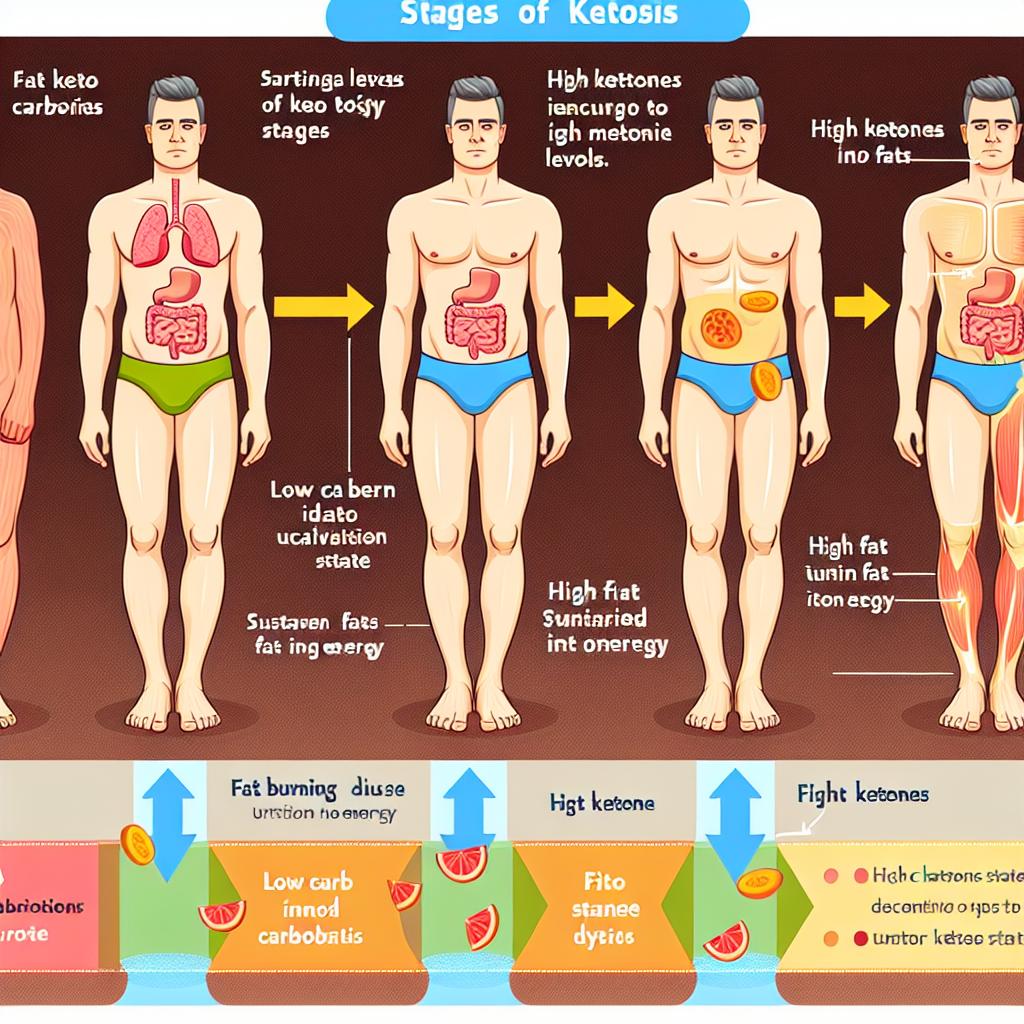This post may contain affiliate links which means I may receive a commission for purchases made through links. Learn more on my Private Policy page.
Understanding the Different Stages of Ketosis: A Friendly Guide to Your Ketogenic Journey
Have you ever thought about how our bodies power through life? Most of us are quite familiar with the energy derived from carbohydrates, but what if I told you there’s a fascinating alternative fuel source just waiting to be tapped? Welcome to the world of ketosis! This metabolic state, where your body shifts from burning glucose to ketones, has been gaining popularity among health enthusiasts and curious minds alike. But what does it really mean to be in ketosis, and how do you navigate its various stages? In this article, we’ll embark on a friendly exploration of the different stages of ketosis, helping you uncover the secrets behind this intriguing process. With a sprinkle of science, a dash of personal insight, and plenty of friendly tips, you’ll soon be equipped to make the most of your ketogenic journey. So grab a cup of herbal tea, settle in, and let’s decode the road to ketosis together!
Exploring the Pathways: How Ketosis Begins and Evolves
When embarking on the journey of ketosis, the process begins with a significant shift in your metabolism. Initially, your body relies on glycogen – stored carbohydrates – for energy. However, as glycogen depletes, typically after 24 to 48 hours of low carbohydrate intake, the body starts to adapt to using fat as its primary fuel source. This transition phase is often referred to as induction. During this stage, you might experience symptoms commonly known as the “keto flu,” which can include fatigue, irritability, and brain fog. Understanding these sensations as part of your body’s adjustment can ease the transition.
As your body becomes more efficient in generating energy from fats, it enters the ketosis stage, characterized by elevated levels of ketones in the bloodstream. At this point, your liver breaks down fatty acids into ketones, which serve as an alternative energy source for the brain and other organs. This leads to enhanced mental clarity and sustained energy levels, making daily activities feel more manageable. The progression can be visualized in a simple table:
| Stage | Characteristics |
|---|---|
| Induction | Body depletes glycogen stores; potential keto flu symptoms. |
| Ketosis | Increased ketone production; improved energy and mental clarity. |
Signs and Symptoms: Recognizing Your Bodys Journey Into Ketosis
As your body transitions into ketosis, it goes through a fascinating series of signs and symptoms that are essential to observe. Many people report experiencing increased energy and mental clarity as the body efficiently burns fat for fuel. This often comes hand-in-hand with a reduction in hunger, allowing you to feel satiated without constant snacking. Keep an eye out for symptoms such as:
- Keto Flu: A period of fatigue, irritability, or headache as your body adapts.
- Bad Breath: A distinct fruity smell due to the production of acetone.
- Increased Thirst: A common indicator as your body eliminates excess water weight.
As ketosis deepens, you may notice further changes that signify your body is shifting into a more fat-adapted state. This includes a pronounced decrease in cravings for sugar and refined carbs, reflecting the reduced reliance on glucose. Some may also experience enhanced physical endurance, owing to the efficient use of fat stores. Key indicators that you may be fully embracing this metabolic state include:
| Indicator | Significance |
|---|---|
| Stable Weight Loss | Consistent reduction in body weight over time. |
| Improved Sleep Patterns | Enhanced restfulness and better-quality sleep. |
| Heightened Focus | Sharpened cognitive function and clarity. |

Fueling Your Progress: Nutritional Guidelines to Enhance Ketosis
Embarking on your ketogenic journey requires more than just cutting carbs; it demands a focused approach to your nutrition that will help you achieve and maintain ketosis. To truly fuel your progress, consider these essential guidelines that will not only promote fatty acid oxidation but also enhance your overall well-being:
- Prioritize Healthy Fats: Incorporate a variety of healthy fats like avocados, olive oil, and nuts. These will provide essential fatty acids and keep you satiated.
- Monitor Protein Intake: Too much protein can kick you out of ketosis. Aim for moderate amounts, focusing on high-quality sources such as grass-fed beef and wild-caught fish.
- Low-Carb Fiber: Include non-starchy vegetables like spinach and broccoli to ensure your meals are nutrient-dense and fibrous without spiking your carb intake.
Understanding your body’s response to food is crucial in these stages. Consider using a simple food tracking method to keep an eye on your macros. A creative way to visualize your intake can be through a table that outlines daily consumption:
| Food Group | Daily Intake (grams) | Example Foods |
|---|---|---|
| Healthy Fats | 165-200 | Avocado, Olive Oil, Coconut Oil |
| Protein | 75-100 | Chicken, Fish, Eggs |
| Low-Carb Vegetables | 20-30 | Spinach, Kale, Broccoli |
By keeping these recommendations in mind and tailoring them to fit your personal goals, you’re setting yourself up for success in each stage of ketosis. Remember, it’s not just about what you eat, but how those choices nurture your body and propel you forward on your journey.

Navigating Challenges: Tips for Maintaining Ketosis with Ease
Staying in ketosis can feel like a balancing act, especially when faced with cravings or social situations involving food. To simplify this journey, consider incorporating these strategies into your routine:
- Meal Prep: Spend a couple of hours each week preparing your meals. Having ready-to-eat ketogenic meals on hand can significantly decrease the temptation to stray from your diet.
- Stay Hydrated: Drinking plenty of water not only helps with hydration but also keeps hunger at bay. Aim for at least 2-3 liters a day to ensure your body is functioning at its best.
- Mindful Snacking: Keep keto-friendly snacks like nuts, cheese, or dark chocolate handy. They can curb hunger and prevent you from reaching for carb-heavy options.
Another vital aspect of sustaining ketosis is understanding your body and its response to different foods. Tracking your macros can provide clarity on what works and what doesn’t. Consider using an app or a simple table to log your daily intake. Here’s a quick reference to monitor your carbohydrate allowance:
| Food Item | Carbs (per 100g) | Keto Friendly? |
|---|---|---|
| Broccoli | 7 | Yes |
| Berries | 12 | In Moderation |
| Potatoes | 17 | No |
By keeping your carb intake in check and focusing on quality, nutrient-dense foods, you will find yourself navigating the challenges of ketosis with much more ease and confidence.
Q&A
Q&A: Understanding the Different Stages of Ketosis
Q1: What exactly is ketosis, and why should I care about it?
A1: Great question! Ketosis is a natural metabolic state where your body shifts from using glucose (carbohydrates) as its primary energy source to burning fat for fuel. When your carb intake is low, your liver converts fatty acids into ketones, which can power your brain and body. Understanding ketosis can be a game-changer for your health goals, whether you’re aiming for weight loss, enhanced mental clarity, or stable energy levels!
Q2: Are there different stages of ketosis? How do I know which stage I’m in?
A2: Absolutely! Think of it like a journey. Ketosis has several stages, typically categorized as:
- Initial Ketosis: This is when your body first begins to deplete its glycogen stores. You may feel a bit foggy or fatigued – often called the “keto flu” – while your body is adjusting.
- Nutritional Ketosis: Once you’ve adapted, you’ll experience stable energy levels and improved concentration. Here, your body efficiently produces and uses ketones.
- Deep Ketosis: This stage involves even higher levels of ketones, often resulting in significant physical and mental benefits. It’s where many people feel their best in terms of energy and mental clarity!
To identify your stage, you can use ketone testing strips or a blood ketone meter. So, keep those detective skills handy!
Q3: How long does it take to enter each stage of ketosis?
A3: The timeline can vary from person to person, based on factors like diet, activity level, and metabolism. Generally, you might enter initial ketosis within a few days, while reaching nutritional ketosis may take a week or more of low-carb eating. Deep ketosis could take a couple of weeks or longer, especially if you keep your carbs below 20-50 grams per day. Think of it as a “keto clock” – everyone’s tick-tock is a little different!
Q4: Are there any signs that I’m in ketosis?
A4: Oh yes! Some classic signs include:
- Increased Energy: That initial fog will lift, and you might feel like you can conquer the world!
- Enhanced Focus: Your brain is now fueled by ketones – hello, mental clarity!
- Keto Breath: Some people notice a distinct fruity smell due to acetone, a type of ketone. It’s like your body’s little way of saying, “Hey, I’m in ketosis!”
- Reduced Appetite: Many experience less hunger, thanks to stabilized insulin levels.
Remember, everyone’s body reacts differently, so not all of these signs may apply to you!
Q5: Can I speed up the process of entering ketosis?
A5: While there’s no magic potion, there are some friendly tips to help you on your journey:
- Limit Carbs: Focus on low-carb foods like leafy greens, meats, and healthy fats.
- Stay Hydrated: Drink plenty of water to help flush out toxins and keep you feeling your best.
- Exercise: Incorporating workouts, especially high-intensity interval training (HIIT), can help deplete glycogen faster and accelerate ketosis.
- Intermittent Fasting: This can be a handy tool for some, as it helps your body transition to burning fat more efficiently.
Just remember, patience is key on this keto voyage!
Q6: What should I keep in mind when trying ketosis for the first time?
A6: Excellent point! Here are a few friendly reminders:
- Listen to Your Body: Everyone reacts differently, so pay attention to how you feel and adjust as needed.
- Don’t Rush It: Embrace the process! Gradual changes often lead to sustainable results.
- Consult a Professional: If you have any health concerns or conditions, chatting with a healthcare provider or nutritionist can be a great idea before diving in.
And most importantly, enjoy the adventure! The beauty of ketosis lies in discovering how your body responds to this new way of fueling itself.
Feel free to reach out if you have more questions. Here’s to happy and healthy ketone-fueled days ahead!
The Conclusion
As we close the door on our deep dive into the fascinating journey of ketosis, let’s take a moment to reflect on the path we’ve traveled together. From the initial spark of curiosity to the vibrant energy that comes with fully embracing the state of ketosis, understanding its different stages equips us with the knowledge to navigate this unique metabolic adventure.
Whether you’re a curious newcomer or a seasoned traveler in the world of low-carb living, remember that each stage has its own rhythm and nuances—like the verses of a catchy song waiting to be mastered. Embrace the process, honor your body’s journey, and listen to what it tells you at each turn.
As you chart your course, don’t hesitate to seek community and share experiences; after all, the journey is often richer when shared with friends. We’re all in this together, celebrating victories, learning from challenges, and cheering each other on through every twist and turn.
So, as you step back into your day-to-day life, carry this newfound understanding of ketosis with you. May it guide you toward healthier choices, invigorating energy levels, and a deeper connection to your body. Here’s to your continued exploration and growth—happy ketosing!

